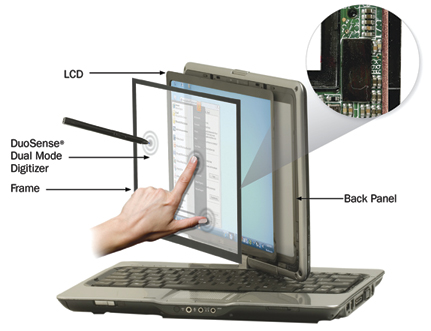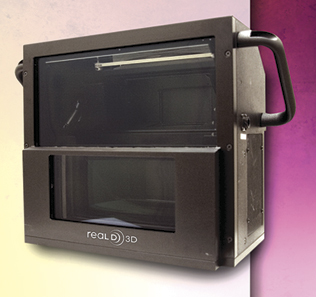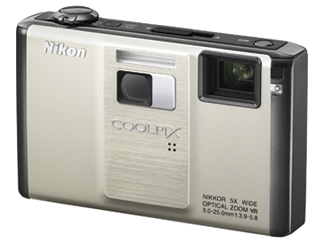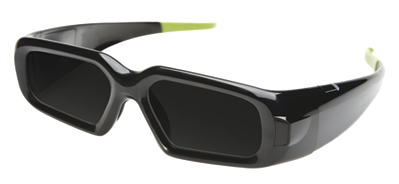2010 SID Display of the Year Award Winners
The Society for Information Display's Display of the Year Awards committee has selected six 2010 award winners that advanced the state of the art of electronic-display products and technology during 2009 in the categories of Display of the Year, Display Component of the Year, and Display Application of the Year.
by Jenny Donelan
"THE electronic-display industry continues to demonstrate a remarkable ability to invent, develop, and bring to market innovative and valuable new display concepts and products," notes Bob Melcher, Display of the Year Awards (DYAs) committee chairman. "The committee had to choose from an impressive list of nominees from three continents. The winners represent contributions to some of the hottest topics in the display industry today, including 3-D, touch, low power, and pico-projectors."
A definite synergy exists between most of this year's award winners and the new special topics of focus for the 2010 Display Week Symposium. Among these topics are 3-D, touch, and green technology. Three products – LG's 3-D LCD panel, RealD's XL Cinema System, and NVIDIA's 3D Vision active-shutter glasses – are designed to further the progress of 3-D, a technology that is definitely living up to its commercial promise. Another winner, N-trig's DuoSense Solution, is designed for pen and multi-touch. And another, Pixel Qi's 3Qi Multimode LCD, uses reflective technology in conjunction with LC to save energy, which is an important part of the symposium's new green-technology focus.
The sixth product, Nikon's CoolPIX S1000pj, a compact digital camera with a built-in VGA liquid-crystal–on–silicon (LCOS) projector, is also exciting because those of us in the display industry have been excited about the commercial potential for pico-projectors for a long time. Now, this technology is being put to use as part of a shipping product that costs less than $500.
These products, and the companies that created them, will be honored at a ceremony during the annual SID luncheon, which takes place on May 26, 2010, during Display Week in Seattle, Washington. During the ceremony, the three Gold Award winners will each present a short video on the winning products.
The award-winning displays, components, and applications are described below, based on information supplied by the winning companies.
Display of the Year
This award is granted for a display with novel and outstanding features such as new physical or chemical effects, or a new addressing method.
Gold Award: LG Display's 47-in. 3-D LCD Panel
LG Display's 47-in. 3-D LCD Panel is the first commercially available TFT-LCD module for 3-D televisions in the mid-40-in. range. The panel works with polarized glasses to provide bright, high-quality 3-D imagery (and vivid 2-D imagery as well) that is comfortable for viewing, without the crosstalk or flicker that can cause dizziness and eye strain.
LG Display has been researching and developing 3-D LCD panels in both stereoscopic (viewed with glasses) and autostereoscopic (no glasses) versions for several years. To create the 3-D LCD, the company developed a new patterned retarder and its own special process of glass lamination.
The patterned retarder separates the polarization states between the odd and even lines so that right- and left-eye images can be seen completely separately. Right-eye images are presented by the odd lines and left images by the even lines. Viewers' right and left eyes, therefore, see different images with the polarized glasses, making the images appear three dimensional. The retarder, in combination with the special glass lamination process, enables a low surface reflection with no moiré pattern, greatly improved luminance, and crosstalk-free imagery.
Crosstalk, which breaks down the stereo-scopic effect, refers to any degradation between the optical separation of the right- and left-eye images as viewed by the observer. The lesser the crosstalk value, the more realistically and comfortably people should be able to view imagery on the 3-D panel.
The panel also uses in-plane switching (IPS) for superior viewing. It employs LG Display's proprietary technology to realize clear imagery and is the brightest of any currently available 3-D LCD panels that use glasses. Moreover, the 3-D viewing works with low-priced polarized glasses. Many other types of 3-D LCD panels require special "shutter" glasses that are relatively expensive. Unlike shutter glasses, polarized glasses have a simple structure without components such as batteries and electronic control units. They are lightweight, stylish, and allow users to comfortably watch 3-D images in the same viewing environment as 2-D.
LG Display's 47-in. 3-D LCD panel provides excellent visual depth while making viewing remarkably comfortable. In addition, it represents a new emphasis for the company and the industry. LG Display CTO and Executive Vice President In-Jae Chung remarks, "The display industry players are shifting their focus from two- to three-dimensional technologies in order to deliver more vibrant and true images. LG Display will step up development of 3-D technologies and products to provide customers and consumers with differentiated value."
Silver Award: Pixel Qi's 3Qi Multimode LCD
Active-matrix liquid-crystal-display (AMLCD) technology is the technology of choice for many applications, from mobile devices to large HDTVs. But there are areas where today's LCD is lacking: it is power hungry, particularly when the display is optimized for high luminance; it is not easily viewable in brilliant ambient light; and it is not considered an ideal medium for comfortable, long-term reading.
These are the challenges tackled by Pixel Qi, a California and Taipei start-up company founded in 2008 by Dr. Mary Lou Jepsen. Jepsen previously co-founded the One Laptop Per Child program, for which she developed an earlier generation of the 3Qi screen. Today's version builds on her experience in delivering sunlight-readable screens for children in less technologically developed countries – from Peru to Nigeria to Nepal.
In developing the newer 3Qi multimode LCD technology, Pixel Qi added another requirement: the display had to be manufactured in existing LCD fabs. The use of standard manufacturing processes and materials enabled rapid ramp-up to volume production of reliable displays at competitive costs: Pixel Qi has been making strides as a genuinely fab-less screen developer.
The 3Qi display has all the advantages of a standard backlit LCD: rendering quality, full-color images and full-motion video, and high screen luminance using regular backlights. But unlike standard displays, in high ambient light levels such as in an office or home, the 3Qi display's reflective mode contributes to the rendered image, allowing the backlight to be turned down or off, which delivers significant power savings and makes for an attractive screen and comfortable reading experience – with exceptionally high resolution. Outdoors, the 3Qi display really shines: its reflective mode renders a crisp image with the look of the best electrophoretic displays. This is the "next generation" of transflective LCDs – each pixel is mainly reflective, enabling high reflectance, but has about the same transmissive efficiency as a standard LCD. The user experiences an excellent reading experience in any light, plus color and video.
This ability to achieve excellence in these multiple modes sets a new standard for LCDs. To achieve this, Pixel Qi has built a strong portfolio of inventions and has nearly 70 patents in process. The first of the 3Qi displays in production is a 10.1-in. WSVGA panel targeted at netbooks, tablets, and e-readers. Backlit, this 600 x 1024 x 3 resolution panel exceeds the typical specification for these targeted applications, with a contrast ratio of 100:1, a wide viewing angle, a color gamut greater than 45% NTSC, and response times supporting full video rates at 60 Hz. The power consumption drops by 80% in reflective mode, while the display delivers a contrast ratio of 10:1 and a hemispheric reflectance approaching 30% – typical of today's best electrophoretic displays.
Additional 3Qi displays will follow, targeting portable devices from smart phones and digital cameras to mid-sized tablets and e-readers, with color in reflective mode as an option.
|
DISPLAY OF THE YEAR
|
|

Gold Award: LG Display's 47-in. 3-D LCD Panel is the first commercially available TFT-LCD module for 3-D televisions in the mid-40-in. range. The panel works with polarized glasses to provide high-quality 3-D imagery.
|

Silver Award: Pixel Qi's 3Qi Multimode LCD is visible indoors and out, delivering color, video, and a clear and crisp reading experience wherever it is viewed.
|
Display Component of the Year
This award is granted for a novel component that has significantly enhanced the performance of a display. A component is sold as a separate part destined to be incorporated into a display. A component may also include display-enhancing materials and/or parts fabricated with new processes.
Gold Award: N-trig's DuoSense Solution (for pen and multi-touch)
Touch is one of the primary channels through which we experience our world and manipulate the objects making up our environment. In order to create a way for people to interact more naturally with their computers, N-trig created the DuoSense Solution, a dual-mode pen and true multi-touch capacitive digitizer, combining all forms of input into a single device for performing tasks with a wide variety of personal-computing devices. Users can employ the pen to annotate on the screen or engage with two or more fingers to manipulate objects directly on the computing device.
N-trig's dual-mode digitizer uses both pen and zero-pressure capacitive touch to provide the company's true hands-on computing experience for mobile computers with a single device. It consists of the following:
• The DuoSense Digitizer: A customized capacitive sensor module, mounted on top of the LCD, which enables direct on-screen manipulation using pen and multiple simultaneous touch inputs, and enhances the overall user experience.
• The DuoSense Pen: Enables users to annotate, draw, and point to objects directly on the screen, complementing the inherent multi-touch capabilities. The DuoSense pen is available as either an electrostatic battery-less pen or a battery-powered Digital Pencil, both of which correspond to the same unique hardware.
- The DuoSense electromagnetic pen requires no external power source. Using a conductive capacitor that is built into the pen, it connects to an electromagnetic field generated by an excitation coil in the digitizer. The frequencies of the conducted electromagnetic waves are controlled by the computer system.
- The Digital Pencil is a wireless electronic pen that uses a standard AAAA battery. The DuoSense software identifies the position of the pencil and the pressure level, removing the need for an integral excitation coil within the DuoSense digitizer and enabling it to be used with any DuoSense-enabled computer.
While N-trig engineers were developing the DuoSense Solution, they faced a number of obstacles with regard to making pen and capacitive touch easy and intuitive to use. One was palm rejection, which involved building a digitizer connection to the computer so the system could understand the difference between a user's palm resting on the screen and intentional finger commands. Another was pen and finger coordination: creating an interface that not only allowed the use of both pen and fingers, but differentiated between the two so that consumers could work with them at the same time. The last was subpixel touch accuracy: ensuring a high degree of precision so that the technology was a fit for both intricate business operations and general consumer use.
While addressing the technical obstacles, N-trig designers found that one of the greater challenges to the adoption of multi-touch was the comfort zone of a conventional mouse and keyboard. Initial meetings to promote pen and multi-touch capabilities were met with skepticism by users who did not believe that anyone would want to directly interact with their computer screen – beyond simple commands. Slowly, this skepticism turned to acceptance, as N-trig demonstrated how natural and easy hands-on computing could be. Today, touch displays are an expected part of computers and are gaining rapid acceptance within education, health-care, business, gaming, social-media, and consumer markets.
Pen and multi-touch screen displays are a natural progression of the way the computing industry is changing and developing, and have become a strategic weapon for manufacturers seeking a competitive edge. Fully compatible with various operating systems, N-trig's DuoSense is a highly technologically advanced system, driving an ecosystem built for the successful adoption of multi-touch and helping create new opportunities for the display industry to transform conventional computer interaction from impersonal input to an intuitive, human exchange.
Silver Award: RealD's XL Cinema System
The RealD XL Cinema System is an efficient polarization modulator that mounts externally to a digital-cinema projector. It works in concert with passive, circular-polarizing eyewear to produce cinematic-quality 3-D images. The product was inspired by the need to present 3-D images on larger screens. Single projector 3-D systems, at the time (around 2006) removed large portions of the available light by using absorbing linear polarizers or spectral division. The XL surpassed competing technologies by employing polarization recovery to double the light throughput of 3-D presentations. A single digital-cinema projector with XL is capable of showing 3-D movies at screen sizes up to 80 ft. in width.
Polarization recovery has been utilized in illumination optics for some time. Scientists working on RealD's 3-D cinema technology met in 2006 to discuss applying recovery principles to the original RealD Cinema System technology. A program was initiated in Boulder, Colorado, currently RealD's center for research and development, to design a polarization recovery modulator. Several months later, two XL prototypes were completed and successfully demonstrated. The prototypes were so well-received that they were promptly packaged and deployed at the Beowulf 3-D movie premieres in Hollywood and London.
The XL design was required to double the polarized light output of the system and, additionally, perform under the conditions of digital cinema. The system is robust in high optical flux (>30,000 lm), as considerable time was spent on process development for each component and subassembly. To maintain cinematic resolution, a careful optical implementation overlays images to extremely tight pixel tolerances. Simple and intuitive overlay adjustments minimize installation time. Once aligned and locked, the system does not require readjustment over its lifetime.
The unit, additionally, could not be too heavy, large, or cumbersome because typical cinema installations are tightly constrained. The XL fits between the projection lens and port window. A simple sliding rail system allows the XL to be removed for 2-D presentations and reinserted in the optical path for 3-D presentations.
The high efficiency of the XL offers many advantages. There is no need to change the projector lamp (or lamp power) for 2-D and 3-D presentations. Lamp power and lifetime are conserved for a greener and more cost-effective theater. 2-D to 3-D changeover is as simple as sliding the unit in or out of the projection beam. And larger screen sizes allow audiences to enjoy movies, live content, and special events in a more immersive environment. Coupled with low-cost reusable and recyclable eyewear, the RealD XL Cinema System provides unmatched efficiency and value in the 3-D cinema industry.
The XL is currently deployed worldwide, and its technology can be utilized across professional and home-theater markets. As the swelling tide of 3-D continues, the XL and the technology behind it can look forward to a very "bright" future.
|
DISPLAY COMPONENT OF THE YEAR
|
|

Gold Award: N-trig's DuoSense Solution, a dual-mode pen and true multi-touch capacitive digitizer, is changing the way users connect with their computers by offering an intuitive hands-on approach to performing a wide variety of tasks on various computing devices.
|

Silver Award: The RealD XL Cinema System mounts to a commercial projector to provide, in conjunction with polarizing eyewear, cinematic-quality 3-D imagery.
|
Display Application of the Year
This award is granted for a novel and outstanding application of a display, where the display itself is not necessarily a new device.
Gold Award: Nikon's COOLPIX S1000pj
The COOLPIX S1000pj is the first compact digital camera to feature a built-in projector. With a simple touch of a button, the camera projects photos or movie clips at up to 40 in. in size on any flat surface. Pictures can be projected individually or as slide shows complete with music and added effects that enhance the experience.
This capability to project still images or movie clips gives birth to an entirely new form of communication, as all participants can share imagery together. For example, the COOLPIX S1000pj can be used to capture photos on a family vacation, then serve double-duty as a personal theater in the evening as everyone enjoys viewing the highlights of the day projected on a wall or a ceiling.
The pico-projector unit, which was minimized in order to be integrated with the digital camera, is based on white-LED illumination optics and incorporates polarizing beam-splitters, a reflective liquid-crystal–on–silicon (LCOS) microdisplay, and projection optics. In order to utilize the light efficiently, Nikon developed optimized illumination optics that include a type of free-form-surface optical element. The projector's specifications include the following:
• Brightness: Up to 10 lm (Measurement, measuring conditions, and method of notation all comply with ISO 21118.)
• Image size: 5–40 in.
• Throw distance: Approximately 10 in. to 6 ft., 6 in.
• Battery life: Approximately 1 hour (Based on continuous use of a fully charged EN-EL12 battery at 25°C/77°F.)
• Output resolution: VGA equivalent
A projector stand is included, as is a remote control that can be used to operate the projector, release the shutter, and perform other tasks. Also featured are the precision optics of a 5x zoom NIKKOR lens that provides the compositional freedom of 28-mm wide-angle coverage and macro shooting ability from as close as 3 cm (1.2 in.). This combines with the image quality and performance benefits of Nikon's innovative EXPEED digital image-processing concept to help ensure consistently clear, high-quality results are produced at the high resolution of 12.1 effective megapixels.
Silver Award: NVIDIA's 3D Vision
A transition to 3-D across all major digital media and entertainment platforms is happening now. With its NVIDIA 3D Vision technology, consisting of software and wireless active-shutter glasses, NVIDIA is helping to bring this technology to consumers, delivering ultra-realistic games, high-definition video playback, a rich movie experience, and crisp photos – all in 3-D with ultra-wide viewing angles. 3D Vision has been designed with top-of-the line optics that are used in conjunction with 120-Hz LCD panels to enable two 1080-pixel full-resolution images per eye in 3-D mode running at 60 Hz per eye. They are comfortable to wear and modeled after modern sunglasses, offering a lightweight alternative to conventional 3-D glasses. 3D Vision eyewear is a fully un-tethered solution, enabling free range of motion and up to 40 ft. of wireless 3-D viewing.
3D Vision works with any 120-Hz certified display, including the newest 3-D HDTVs, computer LCDs, notebook computers, and 3-D projectors. The included NVIDIA software automatically converts over 450 games to work in 3-D stereo out of the box, without the need for special game patches. 3D Vision is also the only stereoscopic 3-D gaming solution to fully support NVIDIA SLI, NVIDIA PhysX, and Microsoft DirectX 11 technologies.
A single charge using a standard USB cable enables over 40 hours of continuous 3-D stereoscopic gaming. Intelligent circuit design built into the glasses automatically shuts them off after 10 minutes of inactivity to preserve battery life.
Powered by NVIDIA GeForce GPUs, 3D Vision is among the world's highest-quality stereoscopic 3-D consumer solution for desktop and notebooks PCs. It forms a foundation for the new consumer 3-D stereo ecosystem for gaming and digital-entertainment PCs, unlocking clear, flicker-free 3-D stereo imagery for driving new experiences in 3-D gaming, movies, photography, and Webstreaming. •
|
DISPLAY APPLICATION OF THE YEAR
|
|

Gold Award: Nikon's COOLPIX S1000pj is the first compact digital camera to feature a built-in projector.
|

Silver Award: NVIDIA's 3D Vision wireless active-shutter glasses have been designed with top-of-the-line optics and offer ultra-wide viewing angles.
|
Jenny Donelan is the Managing Editor of Information Display
Magazine. She can be reached at jdonelan@pcm411.com.